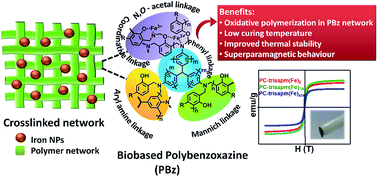Sustainable one-step strategy towards low temperature curable superparamagnetic composite based on smartly designed iron nanoparticles and cardanol benzoxazine†
Abstract
Despite recent advances in polybenzoxazines (PBzs), especially of sustainable origin, the lowering of the curing temperature still remains a challenge in addressing their exploration in low-temperature processing applications. Innovative iron-based catalysts which are naturally abundant, cost-effective, and with larger surface area could demonstrate a practical, economic and facile approach for the development of iron NPs–polybenzoxazine composites. Here we propose an approach to develop a composite based on smartly-capped iron nanoparticles (NPs) and agro-waste phenolic-sourced cardanol benzoxazine monomer as a one-step solution with the benefits of lowering the curing temperature and providing superparamagnetism. NPs are smartly designed with a variation in the nature of the functionality in the capping agent and are characterized by thermogravimetry analysis (TGA), Fourier transform infrared (FTIR), powder X-ray diffraction (XRD), scanning electron microscopy (SEM), and transmission electron microscopy (TEM). The NPs showed a spherical shape of ∼10 nm in size with appreciable magnetic characteristics. Both iron ions and available functionalities in the capping agent endow benefits in lowering the curing temperature of cardanol benzoxazine (64 °C), and enhancing its maximum thermal stability (34 °C), as determined by differential scanning calorimetry (DSC) and TGA, respectively. In addition, the nature of the chemical linkages in the polybenzoxazine network and the initial growth in the molecular weight of the polymer were found to be influenced by iron NPs, as supported by FTIR, nuclear magnetic resonance (1H-NMR), UV-visible (UV-vis) spectroscopy, and gel permeation chromatography (GPC). The capping-agent-facilitated NPs distribution in the polybenzoxazine matrix was determined by atomic force microscopy (AFM). Polymer nanocomposites even with a 5 wt% loading of NPs showed good magnetic saturation and superparamagnetic behavior. The present work demonstrated a one-step solution with the incorporation of NPs in a benzoxazine monomer accounting for modification in the properties of polybenzoxazine composites with the benefits of magnetism.



 Please wait while we load your content...
Please wait while we load your content...